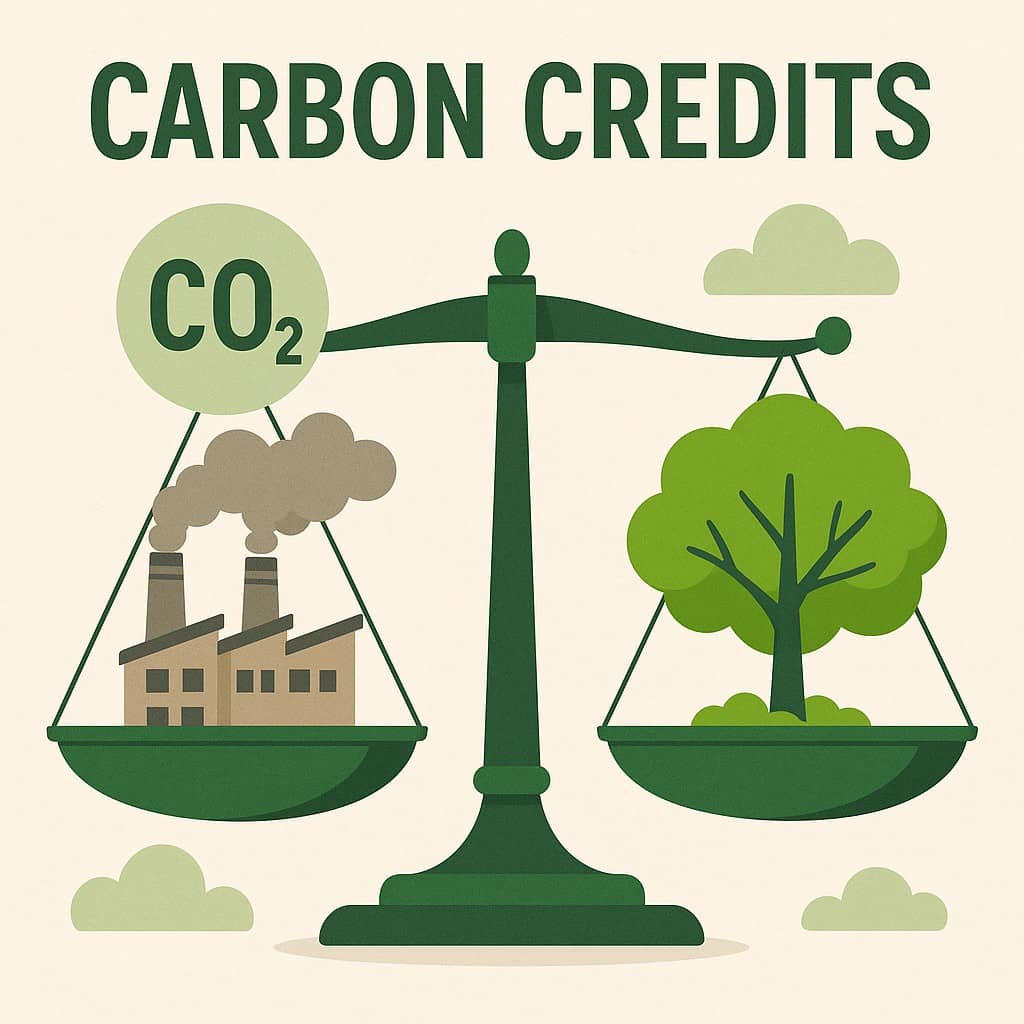
By: Hilda Aku Asiedu,
Development Communicator and SDG Advocate.
email: hildaakuasiedu@gmail.com
LinkedIn: Hilda A. Asiedu
Climate change is no longer just something we read about in global reports or hear during international conferences. It is now part of our everyday reality in Ghana. From flooding in Accra to unpredictable rainfall patterns affecting our farmers in the north, the effects of a changing climate are becoming clearer by the day. Along with these changes, new terms like “carbon credits” and “carbon markets” are making their way into national conversations. These concepts are often presented as solutions and sometimes as opportunities. But what do they really mean for the ordinary Ghanaian?
There have been recent claims that Ghana is now earning money by trading in carbon credits, and that this income could be used to support development initiatives, green jobs, and environmental conservation. While this may sound promising, the concept of carbon credits can seem confusing. That is why it is important to break it down in simple language so that everyone can understand and make informed decisions.
What Is a Carbon Credit and How Does It Work?
Think of a carbon credit like a climate receipt. When a country or company (let’s call them Polluter A) emits greenhouse gases by burning fuel, cutting down forests, or operating large factories, they add harmful gases like carbon dioxide into the atmosphere. Too much of these gases contribute to climate change; the rising heat, unpredictable rains, flooding, and droughts we experience.
Now, imagine Ghana (country B) is doing the right thing, like planting trees, preserving a forest, or using clean energy like solar. Because they are helping the planet, they can be given a “carbon credit.” This credit is then sold to Polluter A, who uses it to claim they’ve helped reduce emissions. But the action actually happened in Ghana, not in their country.
In simple terms, Ghana does the work, and Polluter A pays for it. That’s the basic idea.
Ghana’s Role in the Carbon Market
Ghana is one of the first African countries to fully enter the post-2020 carbon market. We’re doing this by preserving forests, promoting clean cooking stoves, and encouraging sustainable farming. These efforts, when verified by international systems, earn carbon credits that we can sell to other countries or companies looking to meet their climate targets.
Institutions like the Environmental Protection Agency (EPA), the Ministry of Environment, and the Ghana Carbon Market Office are overseeing these processes. Their job is to ensure that the credits are legitimate, the projects are real, and the income earned is channeled to the right places.
Our leaders are paying attention too. Some propose that revenue from carbon trading could support national development, funding pensions, local infrastructure, and green jobs. On paper, it sounds promising.
But critics say carbon credits might not be as great as they sound.
One of the key concerns that is raised is that while Ghana may receive payments for protecting the environment, we still suffer the consequences of pollution caused by other countries. Imagine this scenario: Country A (The Polluter) gives Ghana money to protect a forest. With that deal, Country A continues running its big factories and pumping harmful gases into the atmosphere. Ghana gets some money, but still faces the effects of Country A’s pollution like rising temperatures, flooding, food insecurity, and rising sea levels.
Another issue is whether the money from carbon trading actually reaches the local communities doing the real work. In many cases, farmers, forest communities, and youth groups are responsible for planting trees and protecting the environment. Yet, they often receive little to no financial reward.
Instead, large international organizations, consultants, and middlemen may end up with most of the income. This raises serious concerns about equity and justice within the system.
Some environmental advocates argue that carbon credits are being used by wealthier countries as an excuse to delay taking real climate action. Rather than cutting their own emissions, these countries buy credits from developing nations like Ghana to make it appear as though they are fulfilling their climate responsibilities. This could undermine global efforts to truly reduce pollution.
So, the question is: Are we being paid off to clean someone else’s mess while we still suffering the consequences?
The Value of a Carbon Credit
The price of carbon credits varies depending on the type of market. In the voluntary market, which is where most African countries like Ghana currently operate, the value of a single carbon credit can range from $5 to $30 per tonne. The price depends on how well the project is managed and how credible it is.
Ghana, however, is not limited to this space. Ghana is also active in the regulated market under Article 6 of the Paris Agreement, which allows it to trade directly with other governments in a more structured and transparent way.
The World Bank’s 2023 State and Trends of Carbon Pricing Report states that the global average carbon price is about $35 per tonne, but to meet global climate goals, that price should rise to $80–$100 per tonne by 2030. This means that while Ghana is already earning income through credible and regulated systems, strengthening transparency and scaling high-integrity projects, we could earn more income from selling our credits in the future.
The Realities on the Ground
Let’s look at a real-life example. In one carbon project in Ghana, a partnership was formed between a Netherlands-based organisation, the Forestry Commission, and the Ghana Cocoa Board. The focus was on supporting smallholder farmers. The first step was to document land ownership, which is important for ensuring that carbon benefits go to the right people. The team then collected data on trees such as their size, species, and number. This information helped calculate how much carbon the trees stored.
After that, the project provided tree seedlings for the farmers to plant in areas that had experienced deforestation. These trees helped store carbon, but they also served another purpose; they provided shade, which improved cocoa yields. In this way, the project supported both climate goals and agriculture.
However, farmers raised some concerns that some of these trees can take thirty years or more to mature, meaning it may take decades before they can earn a benefit on this. In contrast, cocoa trees provide income every year. Some farmers felt uncertain about whether the long wait for tree benefits was worth it. Others were unsure if planting trees would limit how they could use their land in the future. These highlight some of the loopholes and challenges that need to be addressed.
The European Union Deforestation Regulation (EUDR) and Its Impact
One recent development that will affect Ghana is a new law passed by the European Union called the EUDR short for the European Union Deforestation Regulation.
This law, officially known as Regulation (EU) 2023/1115, came into full force in June 2023. It states that any cocoa, timber, coffee, or other forest-linked product exported to Europe must come from land that has not been deforested after December 31, 2020.
To comply, companies must provide detailed information, including geographic coordinates and legal documents, proving that their products are deforestation-free. Larger companies will be expected to meet this rule by the end of 2025, while smaller businesses have until mid-2026.
This law has big implications for Ghana, which exports large amounts of cocoa and timber to the EU. It means we must now prove that our farming and forestry practices are environmentally responsible. Carbon credit projects that protect forests and restore degraded lands can help us meet these requirements. By doing so, we can continue to access important international markets and support our farmers with climate-smart solutions.
Moving Forward Together
Ghana can take advantage of many opportunities through the carbon market. If we are strategic, national programs like “Greening Ghana” and “Planting for food and Jobs” can be linked with carbon projects to attract funding and create employment. At the same time, offering consistent financial rewards to farmers who protect trees can ensure they stay committed over the long term. Additionally, adopting agroforestry where cocoa is grown alongside shade trees can improve both cocoa yields and climate outcomes.
However, this work cannot be left to the government and companies alone. Climate change affects all of us, and so does the carbon market.
Organisations must invest in energy-saving technologies and reduce emissions. But individuals also have a role to play. From planting trees to using public transport or supporting local green efforts, each action matters. The key is making sure people understand the benefits and are motivated to participate.
What then, Should Ghanaians Know?
Carbon credits are not a magical source of free money. They come with responsibilities. We need to ask important questions: Are these projects real and effective? Are communities truly benefiting? Are we being paid fairly? And are the polluting countries doing their part?
This is a conversation that is meant not only for climate experts or politicians. It is for the farmer who may be asked to plant trees on his land. It is for the young person looking for green jobs. It is for the community leader protecting local forests. And yes, it is for you reading this article today.
The carbon market is here. Let’s make sure it works in the interest of Ghanaians not just for global polluters or private profits.
Did you know how carbon credits worked before reading this article? If not, I hope you do now. Let’s keep the conversation going.

